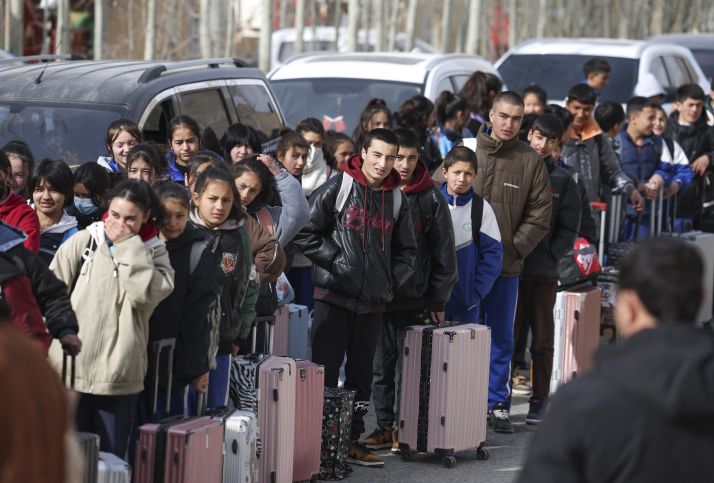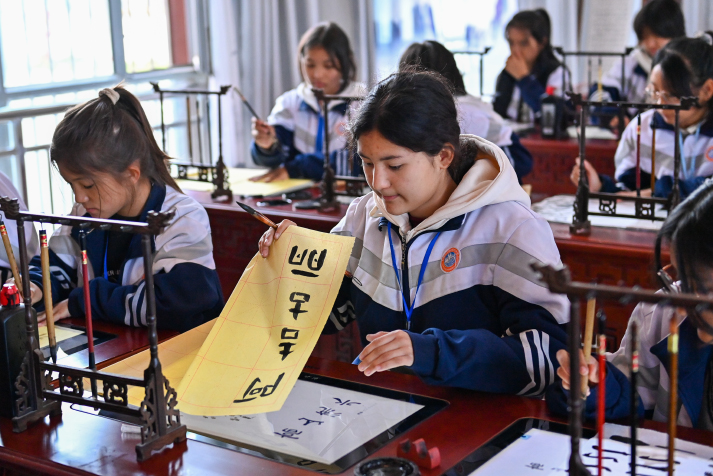| Voice |
| Equality in education | |
|
|
 Middle school students wait at a bus station to return to school in Xihexiu Township, Yecheng County, Xinjiang Uygur Autonomous Region, on February 26 (XINHUA)
My personal experience can serve as a reflection of the education situation in Xinjiang Uygur Autonomous Region. I was born into an ordinary family in a southern prefecture of Xinjiang. My father was a bank clerk and my mother a housewife dedicated to caring for her seven children. In 1996, when my father passed away, I was only in sixth grade, and my younger brother was in third grade. Despite this challenging situation, all seven siblings in our family received full-time education. The country implemented a range of financial support mechanisms, including tuition remission, student loans, scholarships, and work-study programs, to assist students facing financial challenges, like myself, to successfully complete our education. These measures were designed to alleviate their financial burden and provide equal access to educational opportunities. In 2005, I secured a place at Shanghai-based Fudan University (one of China's premier institutions) after passing the college entrance exam. Upon entering Fudan University, I received financial aid of 10,000 yuan ($1,390), which significantly exceeded the university's tuition fee of 6,000 yuan ($834) that year. My academic journey continued at Beijing-based Tsinghua University, where I was accepted for both my master's and doctoral studies under the Cultivation Program for High-level Backbone Personnel From Ethnic Minorities. I was fortunate to receive various scholarships and grants from Tsinghua totaling more than 150,000 yuan ($21,000), further acknowledging and facilitating my research and academic progress. Among the seven children in my family, three have successfully obtained a bachelor's degree or higher, while four have earned their high school diplomas. My story is one of many illustrating the broader impact of national policies that favor the education of ethnic minorities. Entry for all The Chinese Government has significantly prioritized educational advancement, particularly for ethnic minorities. In 1949, Xinjiang grappled with an illiteracy rate exceeding 90 percent, but by 2022, this figure had been remarkably reduced to 2.66 percent, marginally lower than the national average. Back in 1949, Xinjiang's educational infrastructure was minimal, with just one university, nine middle schools, and 1,355 primary schools, resulting in a meager 19.8-percent enrollment rate among school-age children. Fast forward to 2020, and every village boasted kindergartens. The region had expanded to include 3,641 primary schools, 1,211 regular middle schools, 147 secondary vocational institutions, and 62 colleges and universities. The statistics reflect a dramatic improvement in educational participation: preschool enrollment exceeding 98 percent, primary school enrollment rates above 99.9 percent and a retention rate surpassing 95 percent for nine-year compulsory education. By 2020, school enrollment in Xinjiang had reached 6.497 million students, with ethnic minorities making up 74.57 percent at 4.845 million. Remarkably, by that year, 16,536 out of every 100,000 residents had attained university-level education. Overall, the region had produced 2.12 million college graduates, 767,000 of whom were from ethnic minorities, comprising 36.3 percent of all graduates. In a move to bolster the academic development of all ethnic groups, since 2000, China has facilitated special senior high school classes for Xinjiang students in several of the country's more economically advanced cities. By 2021, this initiative expanded to 93 high schools across 45 cities in 14 provinces, welcoming over 130,000 students, many of whom are ethnic minorities from Xinjiang's remote rural communities. This commitment to diversity and inclusivity in education has brought about the prioritization of ethnic minority students' education at all levels, from remote rural areas to university campuses.  Students practice calligraphy at Xuesong Middle School in Akto County, Xinjiang, on November 8, 2023. Teachers at the school are from Jiangxi Province and volunteered to work there as part of a program to improve education in Xinjiang by transferring quality teachers (XINHUA)
In 2011, China initiated vocational education programs tailored for Xinjiang, involving 33 distinguished vocational schools across nine economically advanced provinces and cities, to annually admit 3,300 middle school students from Xinjiang, with a significant number from ethnic minorities in the region's south. Moreover, since 2006, the Cultivation Program for High-level Backbone Personnel From Ethnic Minorities has allowed for admission of postgraduate students from ethnic minority areas into universities in more developed regions. By 2021, this program had supported 57,000 graduate students, with 8,000 from Xinjiang, contributing to a steady rise in Xinjiang's ethnic minority graduates. I am a beneficiary of this initiative, having pursued my graduate studies at Tsinghua. Efforts in Xinjiang to develop a high-level ethnic minority workforce have been bolstered by programs like the Special Cultivation of Scientific and Technological Backbone of Ethnic Minorities in Xinjiang, alongside other educational strategies. The number of Uygur postgraduates surged from 962 in 2000 to 11,432 in 2020, a nearly twelvefold increase, including 988 master's and 1,533 doctoral graduates. Secured diversity In my current academic role as a professor, I have the pleasure of teaching a diverse body of both graduate and undergraduate students, including those from ethnic minority groups in Xinjiang. Many of the students I supervise are from Uygur, Kazak and other ethnic minority backgrounds. It is evident that institutions like Xinjiang University prioritize the admission and nurturing of ethnic minority students across all levels of academia, reflecting a commitment to educational inclusivity and support for ethnic minority groups. China has been advancing educational opportunities for ethnic minorities, particularly in Xinjiang, where the Uygur population forms a substantial majority in southern prefectures. In these areas, students benefit from a 15-year free education program that spans from kindergarten through high school, ensuring that every child has access to education. To promote linguistic diversity and preservation, schools in Xinjiang offer courses in Uygur, Kazak, Kirgiz, Mongolian and Xibe, alongside standard Chinese. This dual-language curriculum safeguards ethnic minorities' rights to learn and use their own languages. The Xinjiang Education Press supports these efforts by developing and distributing educational materials in these languages, including textbooks and supplementary reading materials for primary and secondary school students. In 2023, educational funding in Xinjiang soared to 103.9 billion yuan ($14.45 billion), prioritizing initiatives like free preschool education in rural regions, rural kindergarten construction, and the enhancement of nutritional programs and school security infrastructure. In short, the right to education of ethnic minorities in Xinjiang has already been guaranteed with the level of education improving continually. The majority of ethnic minorities have changed their destinies through education, which is leading to happier lives. The author is an associate professor at the School of Journalism and Communication, Xinjiang University Copyedited by G.P. Wilson Comments to zhaowei@cicgamericas.com |
|
||||||||||||||||||||||||||||||
|